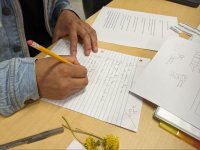Helping English Language Learners Decipher Tough Texts
Teachers can help ELL students read at higher levels by emphasizing sentence structure and meaning making.
Your content has been saved!
Go to My Saved Content.Helping newcomer students who have interrupted educational backgrounds read high-level English texts is an enormous challenge for classroom teachers. How do you create meaning from a huge block of text when students are struggling with basic phonics? How do you engender understanding of an English text when students are emerging English language learners (ELLs)?
This school year I taught a class of all emerging English high school learners (generally level 1 ELLs), and I noticed that their strategy of dealing with an English text was to take out their cellphones and use Google Lens to automatically translate text in the picture. Although I didn’t want to fully discourage student use of this tool, from a teaching perspective, I didn’t want them to rely on this as their only tool. As a language learner myself, I know that simply translating a block of text is not how I learn a new language. The process of figuring out meaning helps cement new information into my brain.
The challenge is how to encourage students to engage with text in a way that maintains student engagement throughout the lesson, while making the information comprehensible. This is the routine I used.
Partner Reading Routine
I created a collaborative protocol that enabled students to work together to make meaning of the new language they were encountering. After building background, introducing key vocabulary, and chunking the text into manageable parts for pairs of students, we would begin with the partner reading routine. This is the five-step process:
1. Teacher reads, students listen. Students are able to hear fluency from an English speaker.
2. Students read. Students work in pairs and switch off reading, following along as their partner reads.
3. Students read again. Students read their chunk of text a second time because the repeated reading allows for increased fluency and comprehension.
4. Students determine what it means. Students comb the text for at least three subject and verb pairs, marking them with our annotation technique.
Then, they speak to each other about what it means. I provide sentence frames, and we spend time modeling how to have an academic discussion in English. If possible, I strategically pair students who can speak to each other in their home language, since allowing students time to process in their home language increases both comprehension and English fluency.
In this step, students translate single words or short phrases with an online or physical word-to-word dictionary. This is an opportunity for students to develop dictionary skills, as long as the bulk of the time is not spent searching for the word. At first I observed students using their phones to translate large blocks of text, but as they gained more experience with the routine, students began to trust the process and only translated words they really did not know.
5. Write what it means. The last step is taking what they understood it to mean in their home language and putting it into English. Students are expected to write a short sentence with a “who or what,” a “do,” and a short object phrase that describes what, where, when, or how. At the beginning of the year, I found students going right to Google Translate, but as they established trust in the process, they saw what they could do without relying on translation. Later on or the following day, I might use the sentences that students generated as a lesson in grammar or as the prompt for a class discussion on meaning.
breaking the code of the english language
After a few months of using this strategy, students were constructing meaning from complex texts orally and in writing. The basis of the protocol is a strong foundation in basic English sentence structure. Throughout the year I explicitly, routinely, and systematically teach that every sentence has a subject and a verb. We combined the word subject with who or what. And a verb is what the who or what does. We started with simple, bare-bones sentences (e.g., “The tools lean” or “The dogs bark”).
Following the structure of the now-out-of-print curriculum Framing Your Thoughts and the work of William Van Cleave, I add on more pieces of the sentence—pronouns, adverbs, prepositions (which is the order laid out in most curricula). Slowly we begin moving into more complex sentence patterns, such as sentences that start with dependent clauses. Although teaching grammar in a vacuum is generally not considered to be best practice, I believe that when taught in the context of language learning and deciphering text, it gives students the tools they need to construct meaning.
This strategy showcases the amazing things that newcomers to English are capable of, and it enabled them to access much higher level text. The routine can be adapted in many different ways. For example, for classes that need more support, student pairs could wait for teacher direction after each step. Occasionally, I had certain students use a list and check off each task as they went.
In classrooms where there is such a gap between the content and what students are able to access on their own, it can be hard to find ways for students to take on the majority of academic tasks. The routine and the foundation in sentence structure enabled students to take on significant intellectual work while also hitting all four language domains. Following strong routines, separating tasks into manageable parts, and breaking down the code of the English language are all useful tools to help students succeed.
